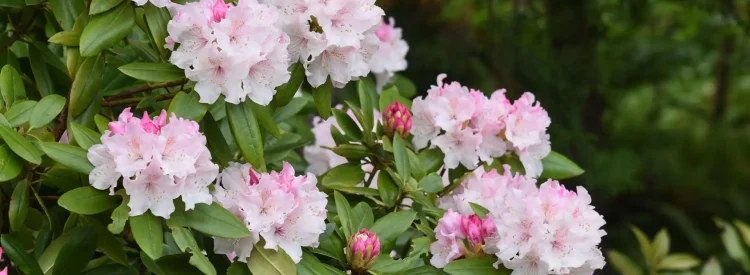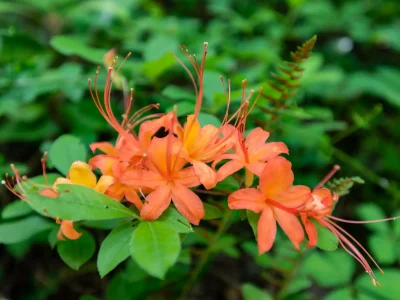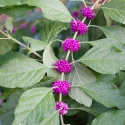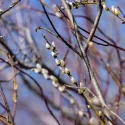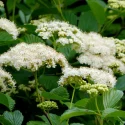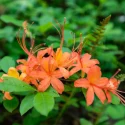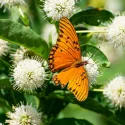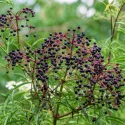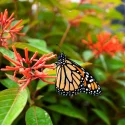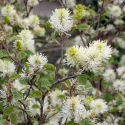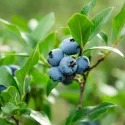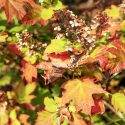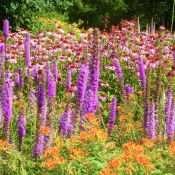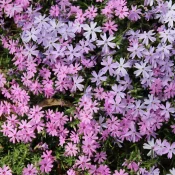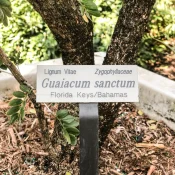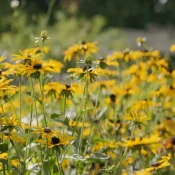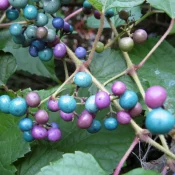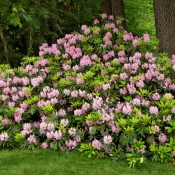If you’re looking for a stunning entryway or statement shrub, native rhododendrons are a stellar choice. These stately evergreen beauties grow from 4-20 feet tall (depending on the species) with glossy leaves no matter the season. In the spring, small bouquets of five-petal flowers open and attract early pollinators. They like part sun to shade, and after the first year are happy with normal rainfall. Plant a few over a weekend and they can last for decades. Scroll down to see what rhododendrons are native.
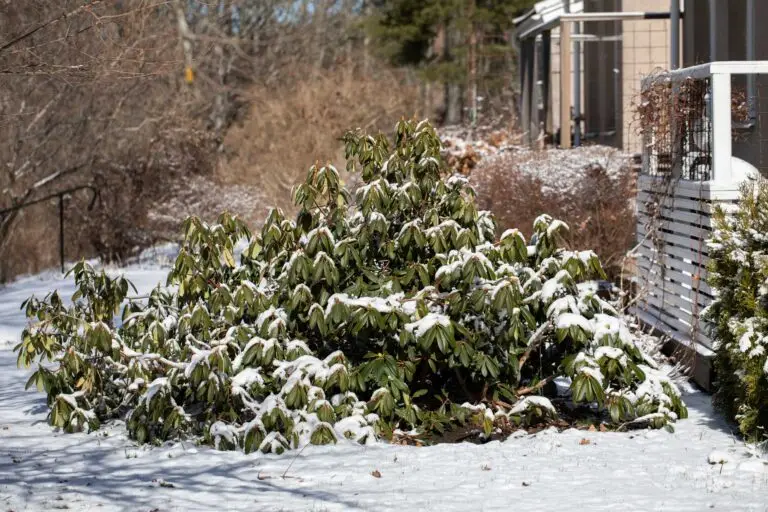
What are the benefits of planting native rhododendrons?
Native plants are always a smart choice for your garden—and native rhododendrons are no exception. Here’s why they stand out:
- Adapted to thrive: These plants are perfectly suited to the local climates and soil conditions of their native ranges, making them low-maintenance additions to your yard.
- Wildlife-friendly: Native rhododendrons provide food and shelter for birds, butterflies, and pollinators, helping your garden become a haven for local wildlife.
- Year-round appeal: With glossy evergreen leaves and spring blooms, native rhododendrons bring beauty and resilience to your landscape—and thrive in a variety of conditions.
The world is filled with rhododendrons
Did you know there are over 1,000 species of rhododendrons worldwide? An incredible 90% of them originate from southeastern Asia—including the Himalayas, Tibet, western and central China, and the Philippines.
But what about North America?
What rhododendrons are native to North America?
North America is home to around 25 native rhododendron species. Of those, three are evergreen shrubs—the plants most often referred to simply as “rhododendrons.”
These evergreens are prized for their lush foliage, vibrant blooms, and ability to support local wildlife—all while requiring minimal care. Scroll down to meet each of these native evergreen rhododendrons and discover which one is right for your garden.
What about the other native Rhododendron species?
If only three of North America’s native rhododendrons are evergreen, what about the rest?
Most go by another name: azaleas.
So, what’s the difference between rhododendrons and azaleas? Here’s the basic breakdown:
Native Rhododendrons
Rhododendron genus
- Typically evergreen, keeping their leaves year-round
- Feature thicker leaves and larger, showier flowers
- Only three species are native to North America—meet them in this article
Native Azaleas
Also in the Rhododendron genus
- Deciduous, meaning they drop their leaves in winter
- Have smaller, thinner leaves and more delicate, often fragrant blooms
- Curious to learn more? Explore our Beginner’s Guide to Native Azaleas for standout species and planting tips
Ok, one last plant to mention, then it’s onto introducing the three North American rhododendrons.
You may also be asking—
What’s the difference between rhododendrons, azaleas, and mountain laurels?
All three of these shrubs get confused for good reason—they have many similarities. All three are flowering shrubs with native options for North American gardens.
To learn more about their differences, visit our article aptly titled Azaleas vs. Mountain Laurels vs. Rhododendrons—What’s the difference?
Now, let’s meet the three native rhodos!
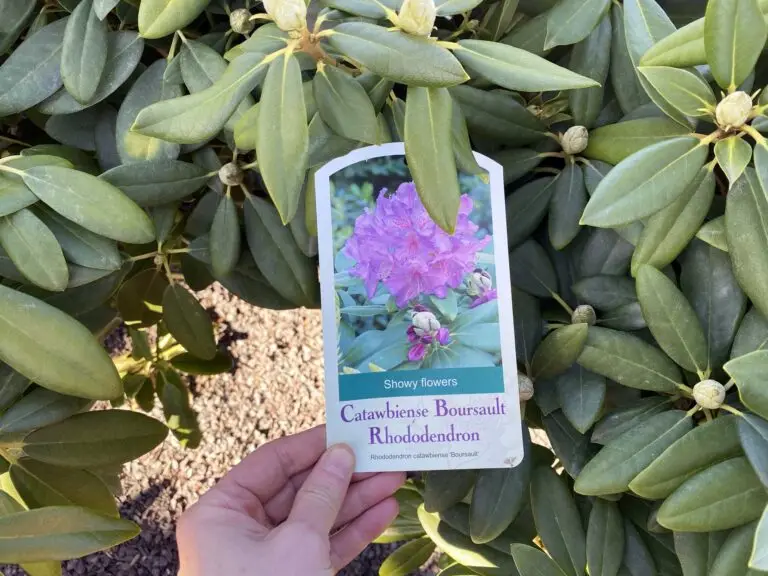
Meet the North American native rhododendrons
The three native plants commonly called “rhododendrons” include:
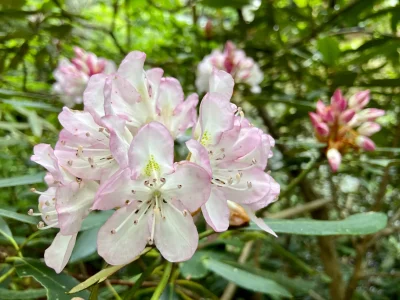
Carolina Rhododendron
Rhododendron carolinianum
Native range: From North Carolina down to Florida and Alabama.
Known for: These are shorter shrubs that grow to around 4 feet tall.
Ideal conditions: Partial shade, with acidic soils.
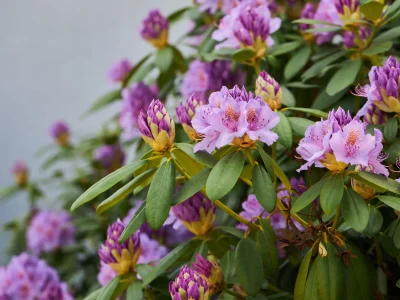
Mountain Rosebay (or Catawba Rhododendron)
Rhododendron catawbiense
Native range: Eastern United States, from Virginia south to Georgia and west to Alabama, Kentucky, and West Virginia.
Known for: Large rose to purple-lilac colored flowers (colors vary from plant to plant.)
Ideal conditions: Moist, acidic soils in shady or part-shade areas.
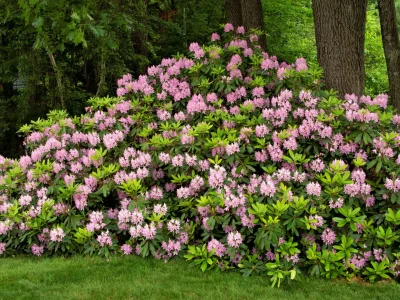
Rosebay Rhododendron
Rhododendron maximum
Native range: The largest native range of the North American rhodos: native from Ontario and Nova Scotia to Georgia.
Known for: Getting large (hence their ‘maximum’ Latin name)—they can grow 10-20 feet wide and tall.
Ideal conditions: Moist, shady areas with acidic soil.
Historic Rosebay Rhodo interlude…
American writer and thinker Henry David Thoreau wrote admiringly about native Rosebay Rhodos used in landscaping in his journal from June 4, 1853 (The Plant Native’s bolding):
“The date of the introduction of the Rhododendron maximum into Concord is worth preserving…They were small plants, one to four feet high, some with large flower-buds, twenty-five cents apiece; and I noticed the next day one or more in front of every yard on each side of the street, and the inhabitants out watering them. Said to be the most splendid native flower in Massachusetts.”
Buying a native rhododendron today will be more than 25 cents, but it’s lovely to know planting them in front yards goes back 150 years. (And we do agree with Thoreau on many things, including Rosebay Rhodos being splendid native flowers.)
We’ve said the word ‘rhododendron’ 20+ times in this article. It might make you wonder…
Where did the name rhododendron come from?
The name rhododendron translates into Rose Tree. According to the American Azalea Society, “Rhododendron is a word of Greek origin, with rhodos meaning ‘rose’ and dendron indicating ‘tree.'”
Wow, what a great Latin name!
Now that we’ve met the three native rhododendrons, you might have some questions about their name and care.
FAQs
Can I plant a native rhododendron in full sun?
North American native rhododendrons can thrive in full sun in cooler climates (like the Northeast). In full sun plantings, ensure they get extra water during dry or hot periods. In the South, part shade to full shade works better.
In nature, native rhododendrons grow in the dappled shade (or full shade) of a larger tree canopy. To mimic this in our gardens, plant them underneath native trees. Some ideas for pairings include native dogwoods and native magnolias.
When should I plant native rhododendrons?
Plant native rhododendrons in the fall or early spring. Planting in the fall is especially advantageous: often native plant nurseries have plant sales, and the native rhodo will spend it’s time on its roots (not leaves). This ensures a happy, thriving plant the following spring.
Dig a hole that is about twice as wide as the root ball and about as deep. Mix some organic matter into the soil to help it retain moisture. Water the plant well after planting, and keep watering it throughout the first year during dry periods.
What does acidic soil mean?
Acidic soil has a lower pH level, meaning it’s on the “cooler” side of a scale that measures how acidic or alkaline soil is.
- pH is measured from 0 to 14, with 7 being neutral.
- Acidic soil has a pH below 7, typically in the 5.0 to 6.5 range for plants like rhododendrons, azaleas, and blueberries.
Think of soil pH like a thermostat in your garden. Some plants thrive in “cooler” acidic soil, while others prefer “warmer” alkaline soil. Knowing your soil’s pH helps you choose the right plants for your yard.
To find out if your soil is acidic, you can easily test it with a pH kit from a garden center. If it’s in the “cool range,” you’re ready to grow acid-loving plants.
Now that I’m thinking about it, what does pH mean?
pH stands for ‘potential of hydrogen,’ which measures the concentration of hydrogen ions in soil, water, or other substances. pH is important in plants because it affects how plants absorb nutrients.
How to grow native rhododendrons
Growing native rhododendrons is easy if you follow a few basic guidelines. Here are a few tips to get you started:
Soil and sun requirements
Native rhodos are understory shrubs: they are found underneath taller trees in nature. To mimic this, plant native rhododendrons in partial shade. Native rhododendrons can tolerate full sun—when they are in cooler climates, especially when kept moist.
Native rhodos prefer acidic soil with good drainage. In nature, acidic soil is often found near evergreen trees, which also love acidic soil. If you already have a place near an evergreen tree, plant a native rhododendron there.
How should I care for native rhododendrons after I’ve planted them?
Native rhododendrons require little maintenance once established. Water the plants regularly during the first year to help them establish their root systems. After that, native rhododendrons should be able to survive on their own with just regular rainfall. (Severe drought will require extra watering, but this is true for most plants in extreme weather.)
What pairs well with native rhododendrons?
There are so many native plants that look great, like acidic soil, and pair nicely with native rhododendrons. Here are some stellar native combinations that look gorgeous.
Shrubs and trees to pair with rhododendrons
A great trio of native plants is rhododendrons + azaleas + mountain laurel. (Here’s a short overview of how these three plants differ.) Delicious highbush blueberries and serviceberries are also native and enjoy acidic soil.
Flowers to pair with rhododendrons
False Blue Indigo and native Wild Columbine are two gorgeous native flowers that thrive in acidic soils and part-shade environments.
Let’s all plant some native rhododendrons
Native rhododendrons are a fantastic choice for gardeners who want to support local ecosystems, do minimal gardening, and love a bloom-filled yard. With their stunning flowers, year-round evergreen foliage, and easy-to-grow nature, these plants are always a garden highlight. Planting native rhododendrons helps preserve the biodiversity of your local community while also creating a vibrant and thriving garden that you can enjoy for years. Add some native rhododendrons to your garden today to sit back and enjoy fuss-free beauty year-round. Visit our Beginner’s Guide to Native Azaleas or head to your local native nursery to start today. Happy planting!
Sources
- Missouri Botanical Garden, Rhododendron catawbiense
- Mount Cuba Center, Rosebay Rhododendron
- Native Plant Trust, Rhododendron carolinianum
- NC State Extension, Rhodendron maximum
- Rhodyman, Native Rhododendrons & Azaleas of North America
- Harris, Marjorie. Botanica North America: The Illustrated Guide to Our Native Plants, Their Botany, History, and the Way They Have Shaped Our World. (2003), 58-61.
- Nelson, Gil. Best Native Plants for Southern Gardens: A Handbook for Gardeners, Homeowners, and Professionals. (2010).
- Staff, HCP. “Special Topics in Horticulture: Rhododendrons – Horticulture Centre of the Pacific.” Horticulture Centre of the Pacific, March 30, 2021.
What if your feed was actually good for your mental health?
Give your algorithm a breath of fresh air and follow us.
